Fig. 1.
Examination of cytokine expression in maternal spleen at various time-points throughout pregnancy and the postpartum period. There is a significant interaction of pregnancy condition and LPS treatment for the expression of IL-1β, IL-6, and IFNγ in the spleen (Treatment × Condition: IL-1β: F5,84 = 3.22; p = 0.010, IL-6: F5,84 = 2.34; p = 0.048, IFNγ: F5,84 = 2.32; p = 0.050; ABC). The expression of both IL-β and IL-6 were significantly attenuated in LPS-treated females at E11 compared to the expression of these same genes in LPS-treated non-pregnant females (IL-1β: p < 0.001; IL-6: p < 0.001; AB). This attenuation was also apparent at E22 for IL-β, IL-6, and IFNγ (IL-1β: p < 0.001; IL-6: p < 0.001, IFNγ: p < 0.001; ABC). The expression of IL-1β and IFNγ immediately returned to pre-pregnancy levels on the day of parturition (P0) as the expression levels of these cytokines in the spleen were not significantly different from non-pregnant females treated with LPS (IL-1β: p = 0.114, IFNγ: p = 0.441; AC). There was a main effect of pregnancy condition and LPS treatment for the expression of IL-4 in the spleen where non-pregnant controls are significantly different than E11 and E22 time-points (Condition: F5,81 = 4.465; p = 0.001, Treatment: F1,81 = 4.293; p = 0.041; D). There was also a significant interaction of pregnancy condition and LPS treatment for the expression of TLR4 (Treatment × Condition: TLR4: F5,84 = 3.15; p = 0.012; Fig. 1E), such that LPS-treated females at E11, E22, P0, and P2 had a significantly attenuated response compared to the LPS-treated non-pregnant females. n = 7–8 rats per group. Condition × Treatment interaction: groups that do not share any capital letters are considered significantly significant (p < 0.05). Main effect of Condition: groups that do not share any lowercase letters are considered statistically significant (p < 0.05). Main effect of Treatment: groups with an asterisk are considered statistically significant (p < 0.05).

